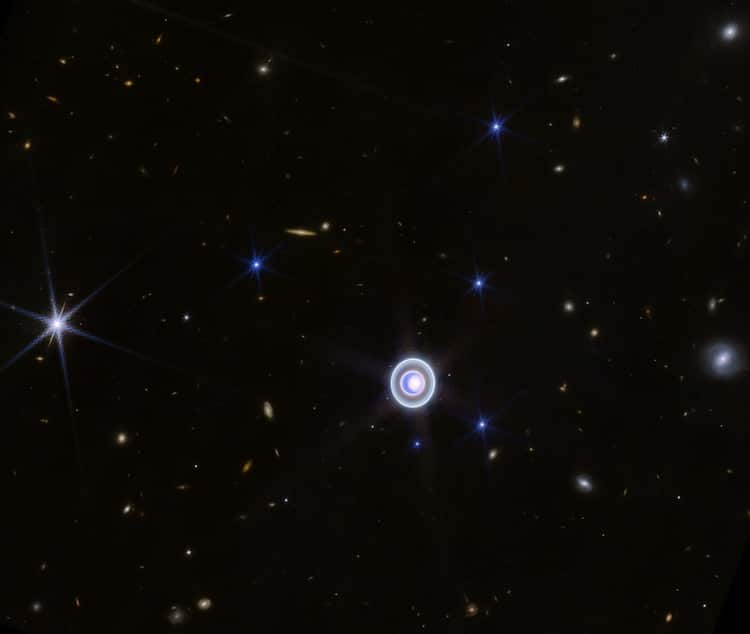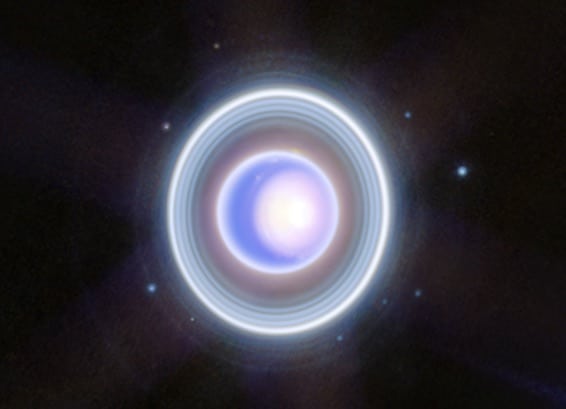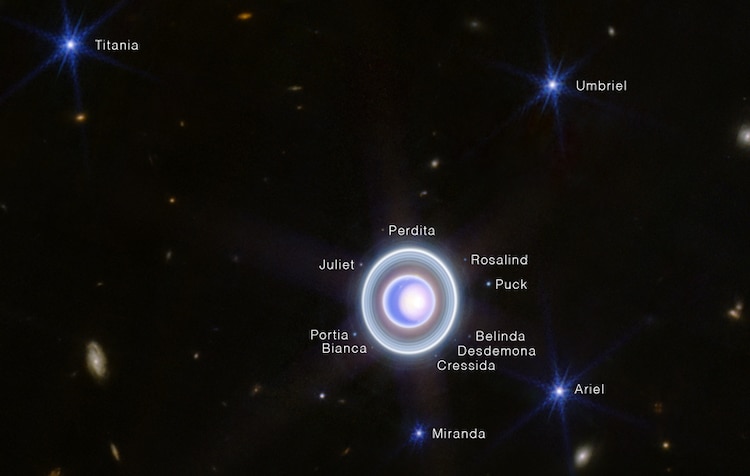
This wide-field image of Uranus from NIRCam (Near-Infrared Camera) on NASA’s James Webb Space Telescope shows the planet amid a smattering of distant background galaxies. This image also includes 14 of the planet’s 27 moons: Oberon, Titania, Umbriel, Juliet, Perdita, Rosalind, Puck, Belinda, Desdemona, Cressida, Ariel, Miranda, Bianca, and Portia. (Photo: NASA, ESA, CSA, STScI)
Once again, NASA’s James Webb Space Telescope (JWST) brings the wonders of space closer to our eyes with a detailed look at Uranus. The new image, which captures the inner and outer rings of the ice giant, was released just before the holidays. Rather than the solid blue planet we normally associate with Uranus, this stunning photo reveals the brilliance of its rings and ice, only visible in infrared light.
The photo is an updated version of an image taken in April of this year. While the previous photo—also taken by the JWST—used two colors, the new edition was taken with “additional wavelength coverage for a more detailed look.” The sensitivity of the JWST was even able to capture the Zeta ring, a diffuse ring that is closest to the planet, and several of the planet’s 27 known moons.
When focusing on the planet itself, the most noticeable feature is Uranus’ seasonal north polar cloud cap, which can be identified by the bright area of white. Unlike Earth, Uranus orbits on its side at a tilt of about 98 degrees, making the entire pole visible to the JWST. This unusual orbit also causes Uranus to have some of the most extreme seasons in our solar system. If you look closely, you can find several storms located along the south of the polar cap, which appear as small bright spots.
Uranus’ polar cap shifts with its journey around the Sun, becoming more prominent as it nears the star. “Uranus reaches its next solstice in 2028, and astronomers are eager to watch any possible changes in the structure of these features,” NASA explains in a statement. More research on the distant planet will help astronomers gain a better understanding of Uranus’ atmosphere and help prepare for future exploration of this exoplanet, and others that are much farther away.
NASA’s James Webb Space Telescope has released stunning images of Uranus, capturing the inner and outer rings of the planet.

This image of Uranus from NIRCam (Near-Infrared Camera) on NASA’s James Webb Space Telescope exquisitely captures Uranus’s seasonal north polar cap and dim inner and outer rings. This Webb image also shows 9 of the planet’s 27 moons – clockwise starting at 2 o’clock, they are: Rosalind, Puck, Belinda, Desdemona, Cressida, Bianca, Portia, Juliet, and Perdita. (Photo: NASA, ESA, CSA, STScI)
The annotated version identifies some of the planet’s 27 moons and a couple of notable stars.

Annotated wide-field compass image of Uranus with some of its 27 moons and a few prominent stars (with characteristic diffraction spikes) labelled.
(Photo: NASA, ESA, CSA, STScI)
Webb Space Telescope: Website | Facebook | Instagram | YouTube
h/t: [IFL Science]
Related Articles:
15 Dazzling Winners of the 2023 Astronomy Photographer of the Year Contest
Breathtaking Timelapse Captures How the Sun Looks During Intense Solar Storms
Astrophotographer Captures All Four Supermoons of 2023 and Combines Them Into One Image
